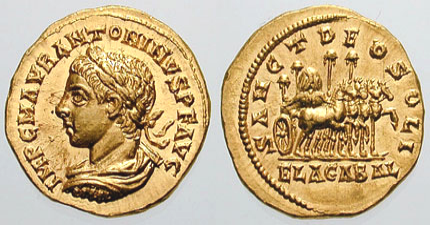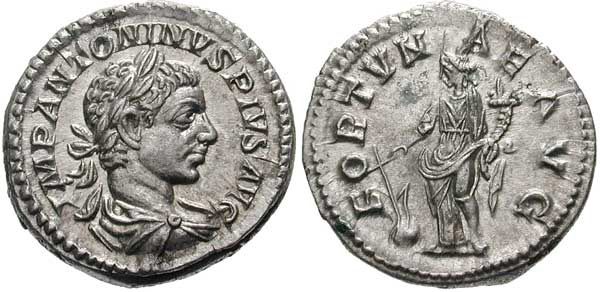|
Julius Bassianus
Julius Bassianus (born in the second half of the 2nd century, died 217) was an Arab high priest of Elagabalus at the ''Temple of the Sun'' in Emesa, Syria, where this solar deity was worshipped in a shape of a black stone. The name Elagabalus derives from ''Ilāh'' (a Semitic word for "god") and ''gabal'' (an Arabic word for "mountain"), resulting in "the God of the Mountain," the Emesene manifestation of the deity. Bassianus was a member of the Royal family of Emesa (modern Homs), which was a part of the Arab aristocracy in this client kingdom of the Roman Empire. The beginning of his priesthood is unknown, but by 187 he was a high priest at Emesa. Bassianus was a son of a Julius and his paternal uncle was Julius Agrippa, who served as a Primipilaris (a former leading Centurion).Levick, ''Julia Domna: Syrian Empress'', p.18 Future emperor Lucius Septimius Severus had visited Emesa, based on a promising horoscope that he would find his future wife in Syria. Bassianus introduced ... [...More Info...] [...Related Items...] OR: [Wikipedia] [Google] [Baidu] |
Baetylus (sacred Stone)
Baetylus (also Baetyl, Bethel, or Betyl, from Semitic ''bet el'' "house of god"; compare Bethel, Beit El) are sacred stones that were supposedly endowed with life, or gave access to a deity. According to ancient sources, at least some of these objects of worship were meteorites, which were dedicated to the gods or revered as symbols of the gods themselves. Other accounts suggest that contact with them could give access to epiphanic experiences of the deity. The baetyl has been described by Wendy Doniger as "the parent form for altars and iconic statuary". In general the baetyl was believed to have something inherent in its own nature that made it sacred, rather than becoming sacred by human intervention, such as carving it into a cult image. Some baetyls were left in their natural state, but others were worked on by sculptors. The exact definition of a baetyl, as opposed to other types of sacred stones, "cult stones" and so on, is rather vague both in ancient and modern so ... [...More Info...] [...Related Items...] OR: [Wikipedia] [Google] [Baidu] |
Julia Soaemias
Julia Soaemias Bassiana (180 – 11 March 222) was a Syrian noblewoman and the mother of Roman emperor Elagabalus, who ruled over the Roman Empire from 218 to 222. She was one of his chief advisors, initially with the support and accompaniment of her mother Julia Maesa. She and her mother guided the young emperor until growing unrest and a family division led to her son's replacement by her nephew Severus Alexander. Julia Soaemias was killed along with her son by the Praetorian Guard. Julia Soaemias was born and raised in Emesa, Syria and through her mother was related to the Royal family of Emesa, and through marriage, to the Severan dynasty of Ancient Rome. Family She was the first daughter of the powerful Syrian Roman noblewoman Julia Maesa and Gaius Julius Avitus Alexianus, sister of Julia Avita Mamaea, niece of Julia Domna, and a niece by marriage of Emperor Lucius Septimius Severus. At some point, she married Syrian Equestrian and Politician Sextus Varius Marcellus, a ... [...More Info...] [...Related Items...] OR: [Wikipedia] [Google] [Baidu] |
3rd-century Romans
The 3rd century was the period from 201 ( CCI) to 300 ( CCC) Anno Domini (AD) or Common Era (CE) in the Julian calendar.. In this century, the Roman Empire saw a crisis, starting with the assassination of the Roman Emperor Severus Alexander in 235, plunging the empire into a period of economic troubles, barbarian incursions, political upheavals, civil wars, and the split of the Roman Empire through the Gallic Empire in the west and the Palmyrene Empire in the east, which all together threatened to destroy the Roman Empire in its entirety, but the reconquests of the seceded territories by Emperor Aurelian and the stabilization period under Emperor Diocletian due to the administrative strengthening of the empire caused an end to the crisis by 284. This crisis would also mark the beginning of Late Antiquity. In Persia, the Parthian Empire was succeeded by the Sassanid Empire in 224 after Ardashir I defeated and killed Artabanus V during the Battle of Hormozdgan. The Sassan ... [...More Info...] [...Related Items...] OR: [Wikipedia] [Google] [Baidu] |
Internet Archive
The Internet Archive is an American digital library with the stated mission of "universal access to all knowledge". It provides free public access to collections of digitized materials, including websites, software applications/games, music, movies/videos, moving images, and millions of books. In addition to its archiving function, the Archive is an activist organization, advocating a free and open Internet. , the Internet Archive holds over 35 million books and texts, 8.5 million movies, videos and TV shows, 894 thousand software programs, 14 million audio files, 4.4 million images, 2.4 million TV clips, 241 thousand concerts, and over 734 billion web pages in the Wayback Machine. The Internet Archive allows the public to upload and download digital material to its data cluster, but the bulk of its data is collected automatically by its web crawlers, which work to preserve as much of the public web as possible. Its web archiving, web archive, the Wayback Machine, contains hu ... [...More Info...] [...Related Items...] OR: [Wikipedia] [Google] [Baidu] |
Emesan Dynasty
The Emesene (or Emesan) dynasty, also called the Sampsigeramids or the Sampsigerami or the House of Sampsigeramus ( ar, آل شمسيغرام, translit=ʾĀl Šamsīġirām), were a Roman client dynasty of Arab priest-kings known to have ruled by 46 BC from Arethusa and later from Emesa, Syria, until between 72 and 78/79, or at the latest the reign of Emperor Antoninus Pius (138–161). Iamblichus, the famous Neoplatonist philosopher of the third century, was one of their descendants, as was empress Julia Domna, matriarch of the Severan dynasty. Onomastics Most modern sources declare the family to be of Arab origin. Roman sources such as Herodian describe the family as Phoenician by genos or stock. Some members of the family such as Julius Bassianus, father of Julia Domma, are described in Roman sources as "a priest of the Sun, whom the Phoenicians, from whom he sprang, call Elagabalus". Writer Heliodorus of Emesa, a descendant of the family, identified himself as "a Phoeni ... [...More Info...] [...Related Items...] OR: [Wikipedia] [Google] [Baidu] |
Severan Dynasty Family Tree
The Severan dynasty was a Roman imperial dynasty that ruled the Roman Empire between 193 and 235, during the Roman imperial period. The dynasty was founded by the emperor Septimius Severus (), who rose to power after the Year of the Five Emperors as the victor of the civil war of 193–197, and his wife, Julia Domna. After the short reigns and assassinations of their two sons, Caracalla () and Geta (), who succeeded their father in the government of the empire, Julia Domna's relatives themselves assumed power by raising Elagabalus () and then Severus Alexander () to the imperial office. The dynasty's control over the empire was interrupted by the joint reigns of Macrinus () and his son Diadumenian (). The dynasty's women, including Julia Domna, the mother of Caracalla and Geta, and her nieces Julia Soaemias and Julia Mamaea, the mothers respectively of Elagabalus and Severus Alexander, and their own mother, Julia Maesa, were all powerful '' augustae'' and instrumental in se ... [...More Info...] [...Related Items...] OR: [Wikipedia] [Google] [Baidu] |
Gaius Julius Alexion
Gaius Julius Alexion ( el, Γάϊος Ἰούλιος Άλεξίων, flourished 1st century) was a Syrian Prince and Roman Client Priest King of Emesa. He was the son of Syrian king Sohaemus and Queen Consort Drusilla. Family Alexion was born to the monarchs Sohaemus of Emesa and Drusilla. The father of Alexion, Sohaemus was an Emesene Prince and ruled as Priest King from 54 until his death in 73. He was the second son of the previous ruling Emesene Monarchs Sampsiceramus II and his wife Iotapa. Alexion's late paternal uncle was the childless Emesene King Gaius Julius Azizus who was the first husband of the Herodian Princess Drusilla, while he had two paternal aunts, Iotapa who married the Herodian Prince Aristobulus Minor and Mamaea. Alexion's mother was a princess from Mauretania, North Africa. Drusilla was the child of the late Roman Client Monarchs Ptolemy of Mauretania and Julia Urania. The mother of Drusilla may have been a member of the Royal family of Emesa and her ... [...More Info...] [...Related Items...] OR: [Wikipedia] [Google] [Baidu] |
Alexander Severus
Marcus Aurelius Severus Alexander (1 October 208 – 21/22 March 235) was a Roman emperor, who reigned from 222 until 235. He was the last emperor from the Severan dynasty. He succeeded his slain cousin Elagabalus in 222. Alexander himself was eventually assassinated, and his death marked the beginning of the events of the Crisis of the Third Century, which included nearly fifty years of civil war, foreign invasion, and the collapse of the monetary economy. Alexander was the heir to his cousin, the 18-year-old Emperor Elagabalus. The latter had been murdered along with his mother Julia Soaemias by his own guards, who, as a mark of contempt, had their remains cast into the Tiber river. Alexander and his cousin were both grandsons of Julia Maesa, the sister of empress Julia Domna, who had arranged for Elagabalus's acclamation as emperor by the Third Gallic Legion. Alexander's 13-year reign was the longest reign of a sole emperor since Antoninus Pius. He was also the second-young ... [...More Info...] [...Related Items...] OR: [Wikipedia] [Google] [Baidu] |
Elagabalus
Marcus Aurelius Antoninus (born Sextus Varius Avitus Bassianus, 204 – 11/12 March 222), better known by his nickname "Elagabalus" (, ), was Roman emperor from 218 to 222, while he was still a teenager. His short reign was conspicuous for sex scandals and religious controversy. A close relative to the Severan dynasty, he came from a prominent Arab family in Emesa ( Homs), Syria, where since his early youth he served as head priest of the sun god Elagabal. After the death of his cousin, the emperor Caracalla, Elagabalus was raised to the principate at 14 years of age in an army revolt instigated by his grandmother Julia Maesa against Caracalla's short-lived successor, Macrinus. He only posthumously became known by the Latinised name of his god. Later historians suggest Elagabalus showed a disregard for Roman religious traditions and sexual taboos. He replaced the traditional head of the Roman pantheon, Jupiter, with the deity Elagabal, of whom he had been high priest. He ... [...More Info...] [...Related Items...] OR: [Wikipedia] [Google] [Baidu] |
Publius Septimius Geta
Publius Septimius Geta ( ; 7 March 189 – 19/26 December 211) was Roman emperor with his father Septimius Severus and older brother Caracalla from 209, when he was named ''Augustus'' like his brother, who had held the title from 198. Severus died in 211, and although he intended for his sons to rule together, they proved incapable of sharing power, culminating with the murder of Geta in December of that year. Early life Geta was the younger son of Septimius Severus by his second wife Julia Domna. He was born on 7 March in either Rome or Mediolanum, at a time when his father was only a provincial governor at the service of Emperor Commodus. In 198, Geta was raised to ''Caesar''. Septimius Severus gave him the title of ''augustus'' in late 209. During the campaign against the Britons in the early 3rd century AD, imperial propaganda promoted the image of a happy family that shared the responsibilities of rule. Geta's brother Caracalla acted as Severus' second-in-command, and ad ... [...More Info...] [...Related Items...] OR: [Wikipedia] [Google] [Baidu] |
.jpg)






